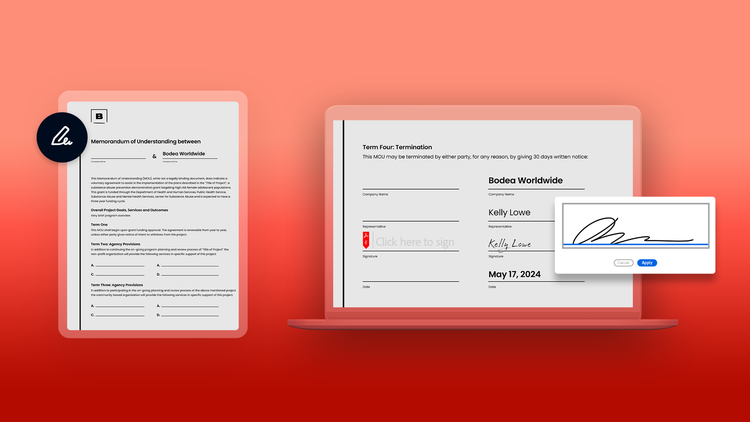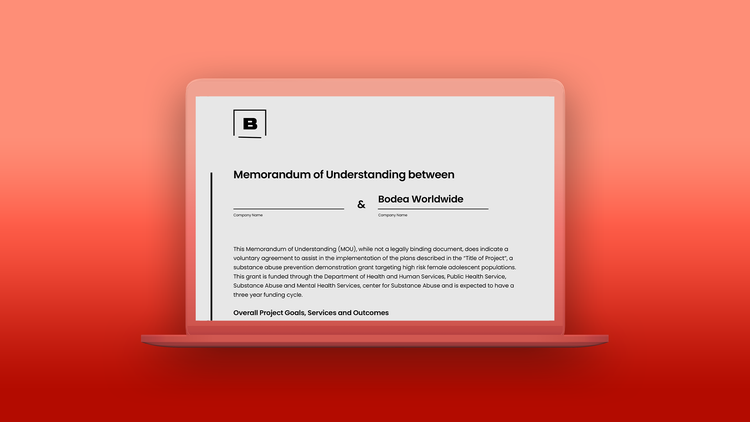Acrobat for business | 10-Minute read
What is a memorandum of understanding (MOU) and how do you write one?
Formalize an agreement with a memorandum of understanding.

What is an MOU?
What is a memorandum of understanding? A memorandum of understanding, or MOU, is a nonbinding agreement that states each party’s intentions to take action, conduct a business transaction, or form a new partnership. This type of agreement may also be referred to as a letter of intent (LOI) or memorandum of agreement (MOA). Under U.S.law, all three are effectively interchangeable.
When to use a memorandum of understanding.
If you or your business is in the beginning stages of a transaction with another party, an MOU is often the first step toward a formal agreement via a binding contract. An MOU clearly defines how the parties will work together and lays out each one’s expectations and responsibilities. The goal is to achieve a mutual understanding of the partnership, so you can move forward into an enforceable contract everyone feels confident about.

Memorandum of understanding example.
A memorandum of understanding can be key when it comes to exploring different strategic partnerships or agreements, since it’s a document that outlines each party’s understanding and expectations.
A well-written MOU explains how organizations agree on the basic structure of their cooperation before diving into the complexities of a formal contract.
As an example, you can think of two shoe companies that are planning to collaborate on developing a new campaign for sports shoes. Before they allocate resources or make any binding decisions, they choose to draft a memorandum of understanding.
This document outlines their intent to share specific resources such as target market data and shoe-developing technology. The MOU serves as a foundation, and it ensures that both parties are aligned in their objectives and understand their roles without the legal obligations of a contract.
MOU benefits and drawbacks.
The benefits and drawbacks of a memorandum of understanding depend on your desired way of doing business.
Memoranda of understanding are not enforceable contracts because no offers a represented and no transactions are made. This arrangement could be a drawback for partners who have already cemented the details of the transaction and are ready to legally commit.
But for many, the fact that MOUs are a step down from a formal contract is why they are so useful. An MOU is also one step up from the informal, unwritten “gentlemen’s agreement.” If casual, verbal comments are the most concrete artifacts you have of your potential partnership, a solid next step might be to elevate your conversations with an MOU.
That way, you can establish a paper trail and keep negotiations moving forward. Each party has the opportunity to review the terms of the agreement, resolve any disputes or miscommunications, and make changes to the agreement before you sign a contract on the dotted line.

What should a memorandum of understanding include?
Every agreement will look slightly different, but a good rule of thumb is to use MOUs as an agreement to agree, not as the final word. You should include whatever terms you feel are necessary to establish a mutual agreement about the common line of action you both will follow.
The MOU format often includes:
- Purpose of the partnership
- Goals of each party
- Duties of each party
- Timeline
- Confidentiality clause
- Process for resolving disputes
Tips for how to write an MOU.
Drafting a memorandum of understanding requires clarity, mutual understanding, and foresight. Here’s a list of steps you can take to get started when you’re ready to write one:
-
Start with a template or begin from scratch. Although this choice depends on the needs of your situation, you can start with an MOU template that helps you outline the basic structure of your contract. You can also start from scratch if you think your situation is unique.
-
Clearly define the parties and the purpose. Identify all the parties involved in the agreement and the purpose of the memorandum of understanding. To begin writing this section, you may ask yourself about the goals of the partnership or the agreement.
-
Outline each party’s roles and responsibilities. Describe the roles and responsibilities of each party. Although you don’t need to be as detailed as when you’re writing a contract, you should still strive to clarify the expectations of the agreement.
-
Include a section for terms and conditions. A memorandum of understanding isn’t legally binding, but it can be helpful in defining the basic terms and conditions. Completing this task sets the groundwork for a mutual understanding when it comes to future agreements.
-
Discuss the scope and limitations of the document. Define what is covered by the memorandum of understanding and what’s excluded. This ensures both parties have a clear and exact understanding of the scope of their agreement.
-
Review, review, review. Thoroughly review the MOU for any inaccuracies, ambiguities, or discrepancies. Give yourself the time to catch errors and mistakes and ensure clarity and mutual agreement.
-
Sign the document. Once both parties are satisfied with the drafted document, you can send it to be signed. While it still won’t be a legally binding contract, signing the memorandum of understanding serves to formalize the mutual commitment to proceed.
Is a memorandum of understanding binding?
While it is not a legal document, certain elements of an MOU could make it a binding and enforceable document in court. Make sure to consult an attorney on the language you use before sending or signing an MOU. According to the Four Corners Rule, a legal doctrine that courts use to determine the meaning of a contract, an MOU could be deemed contractually binding if it includes one or more of the following elements:
- An offer
- An acceptance of an offer
- Intention to be bound
- Consideration (an exchange involving payment or money)

Memorandum of agreement vs. memorandum of understanding.
These two terms sound very similar, but there are a few distinct differences between a memorandum of agreement (MOA) and a memorandum of understanding (MOU).
A memorandum of agreement is a specific document that details the exact responsibilities, contributions, and expectations of each party. It’s often compared to a contract but it doesn’t hold the same legal weight most of the time. Two companies may choose to use an MOA when they need to specify the particulars of their agreement, which can include timelines, specific contributions, and roles and responsibilities.
A memorandum of understanding, on the other hand, is generally broader, and it outlines the intent and understanding between the parties. It can serve as the foundation for cooperation, but it doesn't necessarily dive into specific details. An MOU is typically used in the early stages of negotiation as it sets the stage for a more detailed and legally binding contract or agreement.
MOUs in government agencies and international relations.
The legal definition of an MOU differs in public affairs and in other countries. In international law, MOUs fall under the “treaty” category and must be registered as such with the United Nations. In the United Kingdom, an MOU is often used in the context of agreements that pertain to the government. If your MOU deals with the public or international sector, consult a legal professional to make sure your document works the way you intend it to.
Make your own memorandum of understanding.
It’s easy to create a template to draft up your own MOU. Paperless e-docs save your business time and money, and you can collect e-signatures from anywhere.
Quick revision and open collaboration are essential to a successful MOU. And with Acrobat Pro, you can do it all digitally and keep your partnership on the right track.
